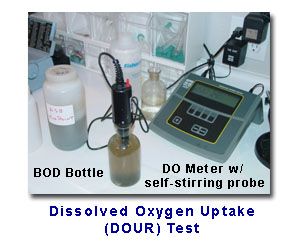Biological waste treatment in the Aerated Stabilization Basin (ASB) process and in Activated Sludge systems is based on the ability of microorganisms to utilize dissolved oxygen in the process of breaking down the soluble organic substances present in the process effluent.
The dissolved oxygen uptake rate (DOUR) test measures the respiration rate of organisms. Since it measures the rate at which oxygen is used (in mg O2/L/hour), it is a useful tool to evaluate process performance, aeration equipment, and biodegradability of the waste. Because solids are not controlled in an aerated stabilization basin (ASB), and the total suspended solids (TSS) is a direct function of biochemical oxygen demand (BOD), loading and biological activity, usually only the absolute uptake rate or dissolved oxygen uptake rate is monitored for aerated stabilization basins. For activated sludge systems, the DOUR is used to calculate a specific oxygen uptake rate, or SOUR, i.e., the amount of oxygen utilized in one hour by one gram of the volatile suspended solids in the activated sludge. Because the oxygen uptake rate is driven upward due to increases in loading (BOD), DOUR is a useful tool in detecting slug loading.
The oxygen uptake test is also useful in detecting toxicity. When toxins are present, the oxygen rate decreases. If one knows the range of uptake rates that are normal for the plant it is easy to see when toxins depress the uptake test and the results can be used to screen wastewater for toxicity and better manage spills within the mill.
When interpreting dissolved oxygen uptake rates the individual numbers are not as important as trends over time. Therefore, dissolved oxygen uptake rate testing must be done on a regular basis in order to for the results to be useful. Dissolved oxygen uptake rate samples should be taken from 2 or 3 points across the system over the period of the retention time. The samples taken 2-4 days into the system will be particularly useful in addressing problems before they become serious issues.
Dissolved oxygen uptake rate is calculated by graphing the dissolved oxygen (DO) of a sample every minute for 10 minutes (lengths of time may vary; at least 1 mg/L difference should exist between the start and end DO values) using a dissolved oxygen probe. The sample should be in a bottle that allows for a tight seal to form with the probe so that no outside oxygen is introduced. Once the values are gathered they are graphed and the slope of the line formed is equal to the uptake rate (expressed in units mg O2/L/hr) when multiplied by 60 min/hr. To calculate the dissolved oxygen uptake rate the following formula is used:
DOUR, in mg O2/L/hr = (DO_initial – DO_final) * 60 / Length of test in minutes
For a full procedure, please contact Environmental Business Specialists at 985-674-0660.

